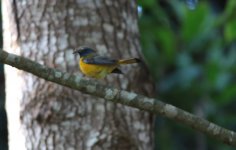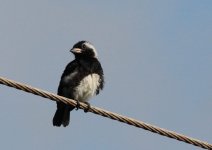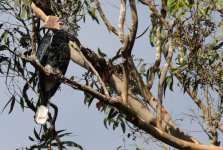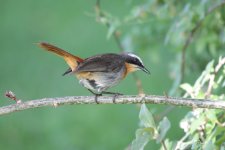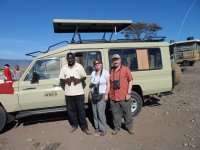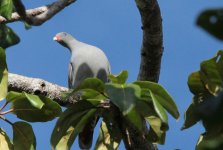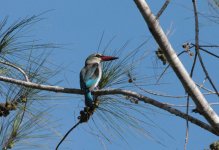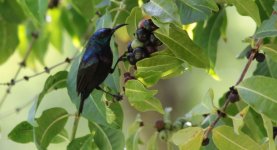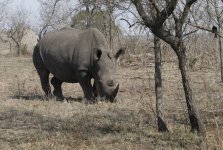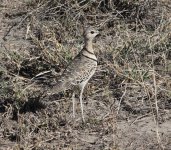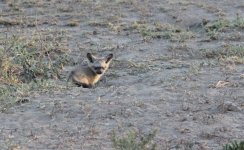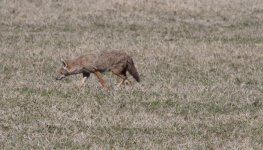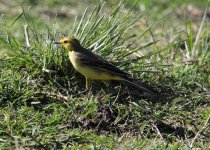West Usambara to East Usambara (13 Dec)
Decided to just do a short walk in the grounds and get over to Amani area by early afternoon as we had been warned forecast was for heavy rain in the late afternoon. This meant no last try at the Usambara Weaver.
Birds before breakfast included African Paradise Flycatcher, tawny-flanked prinia, Yellow-bellied Greenbul, and White-starred Robin.
We were due to stay at Zigi's Guest House at the bottom of the mountain rather than at the Amani Guest House by the reserach station. Zigi's being slightly more modern, however there was no-one staying at Zigi's and there was no power in the area and the generator at the Research Centre didn't power Zigi's so Victor managed to get us moved into Amani, he also said the birds were better up the mountain, not sure that is completely true. Although it was very basic (we had the Blue Suite!), it is set up for shared use by researchers we had a room with two beds and 20 lockers so lots of storage space and there was at least hot water when the generator switched on and lighting a couple of times a day. We dumped our bags and grabbed some lunch before deciding that we would do some general birding round Amani mainly looking for sunbirds rather than go for a target bird.
I think this was a good call because we certainly seen all the sunbirds we were trying for, the best were Ulguru violet-backed, Banded Green, Usambara Double Collared, Purple banded, Amani and Mouse Coloured Sunbirds most of which were new.
In addition we had White-eared and green barbets, Silvery-cheeked Hornbill, Oriole Finch, Black-backed Puffback, Black and White Shrike Flycatcher and Harrier Hawk and even better it stayed dry until we headed back to the digs.
We arranged to go out just after dark to try to see the Usambara Eagle Owl on the trail where Victor had called it down just a couple of days before but just as we were about to leave the canteen after dinner the heavens opened and the path up to the rooms and the trail beyond turned into a river, some hours later it was still raining and we decided to give up and go back to the room (getting soaked in the process) and try again tomorrow.
Early start and a look out the window showed the rain had just abiout stopped, showered and dressed in the dark as generator was not on yet. We decided to head down the hill to Zigi area for some lower elevation species and in the hope that rain would be totally off there. The road was in a pretty poor state after the torrential rain so it took us almost 30 mins to go 7Km down hill, when we got there and got out the vehicle we saw one bird Silvery Cheeked Hornbill, didn't hear any owls calling and then the rain returned and it was very heavy, we waited an hour in the car, then tried again when it looked like the rain had eased off, but no sooner had we got out the vehicle than it came back worse than ever. So we decided that we try again tomorrow for the lower elevation birds and head back for breakfast. It was an interesting 45 minute drive up a flowing river to get back to the Research Centre but by the time we got back up the rain was just about stopped and we determined that we could try for Long-billed tailorbird and other target birds after breakfast.
We set off with waterproofs and without the scope or camera as we thought we would be soaked again but sods law just as it had in the W Usambara's it brightened up and the birds began to show really well. Firstly after a few attempts at calling it we heard the Tailorbird, after a bit of playback we got really good views of perhaps the rarest of the Usambara birds the Long billed Tailorbird, we then saw a mixed flock led by the as yet not described Usambara Drongo (clearly not Fork tailed or Velvet Manteled but awaiting species confirmation based on recent DNA analysis), the rest of the flock were nearly all lifers with a Usambara Hyliota (the first that Victor had ever seen near Amani - although a colleague had four records in the area), a noisy Green-headed oriole, Montane Tiny Greenbul, Striped Greenbul and Black-headed Bush Shrike, we also heard Fischers Turaco but despite trying to call it in couldn't see it.
Once the activity had died down and it was now pretty hot in the sunshine we headed back to centre. I set two chairs up on the porch and we waited for birds to come to us before heading for lunch, not a lot showed just Olive Sunbird, White-eared Barbet and Silvery Cheeked Hornbill, then when Sarah decided to go inside a nice bright Fischer's Turaco landed in the trees opposite, despite trying to call her in a hushed shout the bird reamained but when I had to get up and get her the bird decided to fly off. Despite telling Victor that Sarah now really wanted a Fischer's Turaco . (Note - he tried calling it at every forest opening over the next two days but despite lots of heard birds Sarah never did get to see one). Still a after the start we had it was a good morning and we still had a late afternoon and evening walk to look forward to.
Decided to just do a short walk in the grounds and get over to Amani area by early afternoon as we had been warned forecast was for heavy rain in the late afternoon. This meant no last try at the Usambara Weaver.
Birds before breakfast included African Paradise Flycatcher, tawny-flanked prinia, Yellow-bellied Greenbul, and White-starred Robin.
We were due to stay at Zigi's Guest House at the bottom of the mountain rather than at the Amani Guest House by the reserach station. Zigi's being slightly more modern, however there was no-one staying at Zigi's and there was no power in the area and the generator at the Research Centre didn't power Zigi's so Victor managed to get us moved into Amani, he also said the birds were better up the mountain, not sure that is completely true. Although it was very basic (we had the Blue Suite!), it is set up for shared use by researchers we had a room with two beds and 20 lockers so lots of storage space and there was at least hot water when the generator switched on and lighting a couple of times a day. We dumped our bags and grabbed some lunch before deciding that we would do some general birding round Amani mainly looking for sunbirds rather than go for a target bird.
I think this was a good call because we certainly seen all the sunbirds we were trying for, the best were Ulguru violet-backed, Banded Green, Usambara Double Collared, Purple banded, Amani and Mouse Coloured Sunbirds most of which were new.
In addition we had White-eared and green barbets, Silvery-cheeked Hornbill, Oriole Finch, Black-backed Puffback, Black and White Shrike Flycatcher and Harrier Hawk and even better it stayed dry until we headed back to the digs.
We arranged to go out just after dark to try to see the Usambara Eagle Owl on the trail where Victor had called it down just a couple of days before but just as we were about to leave the canteen after dinner the heavens opened and the path up to the rooms and the trail beyond turned into a river, some hours later it was still raining and we decided to give up and go back to the room (getting soaked in the process) and try again tomorrow.
Early start and a look out the window showed the rain had just abiout stopped, showered and dressed in the dark as generator was not on yet. We decided to head down the hill to Zigi area for some lower elevation species and in the hope that rain would be totally off there. The road was in a pretty poor state after the torrential rain so it took us almost 30 mins to go 7Km down hill, when we got there and got out the vehicle we saw one bird Silvery Cheeked Hornbill, didn't hear any owls calling and then the rain returned and it was very heavy, we waited an hour in the car, then tried again when it looked like the rain had eased off, but no sooner had we got out the vehicle than it came back worse than ever. So we decided that we try again tomorrow for the lower elevation birds and head back for breakfast. It was an interesting 45 minute drive up a flowing river to get back to the Research Centre but by the time we got back up the rain was just about stopped and we determined that we could try for Long-billed tailorbird and other target birds after breakfast.
We set off with waterproofs and without the scope or camera as we thought we would be soaked again but sods law just as it had in the W Usambara's it brightened up and the birds began to show really well. Firstly after a few attempts at calling it we heard the Tailorbird, after a bit of playback we got really good views of perhaps the rarest of the Usambara birds the Long billed Tailorbird, we then saw a mixed flock led by the as yet not described Usambara Drongo (clearly not Fork tailed or Velvet Manteled but awaiting species confirmation based on recent DNA analysis), the rest of the flock were nearly all lifers with a Usambara Hyliota (the first that Victor had ever seen near Amani - although a colleague had four records in the area), a noisy Green-headed oriole, Montane Tiny Greenbul, Striped Greenbul and Black-headed Bush Shrike, we also heard Fischers Turaco but despite trying to call it in couldn't see it.
Once the activity had died down and it was now pretty hot in the sunshine we headed back to centre. I set two chairs up on the porch and we waited for birds to come to us before heading for lunch, not a lot showed just Olive Sunbird, White-eared Barbet and Silvery Cheeked Hornbill, then when Sarah decided to go inside a nice bright Fischer's Turaco landed in the trees opposite, despite trying to call her in a hushed shout the bird reamained but when I had to get up and get her the bird decided to fly off. Despite telling Victor that Sarah now really wanted a Fischer's Turaco . (Note - he tried calling it at every forest opening over the next two days but despite lots of heard birds Sarah never did get to see one). Still a after the start we had it was a good morning and we still had a late afternoon and evening walk to look forward to.
Attachments
Last edited:




